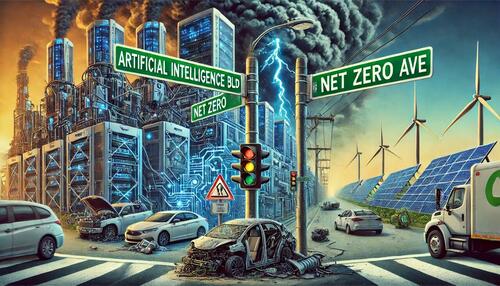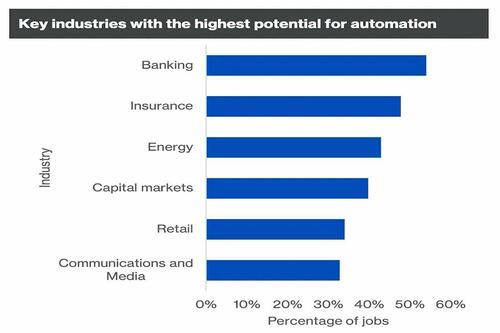Via Energy Security and Freedom,
The Big Green Grift, the Energiewende and all the other green energy scams are about to be slowly shuttled aside because we need massive amounts of new energy these schemes cannot deliver. Moreover, we can no longer afford the virtue signaling, power seeking and money grabbing nonsense these ventures involve. Indeed, there's a big wreck about to happen at the intersection of Artificial Intelligence Boulevard and Net Zero Avenue. Future AI data center demand Is forcing energy discussions to suddenly get very real.
Google, of course, is already facing the fact the two streets it’s simultaneously traveling are not parallel roads, but, rather, two routes that intersect and the company will be forced to stop and decide which direction it wants to go. Net Zero Avenue, taken to the end of the highway leads the end of Google’s AI dreams, while Artificial Intelligence Boulevard promises huge rewards.
We wrote about this Google dilemma and which way the evil company will go here. The situation is also nicely summarized in a new report titled “The U.S. Needs a Bigger (Energy) Boat: Putting The Sheer Magnitude of Forecasted Energy Demand into Perspective,” from Pickering Energy Partners. Here are some powerful excerpts (emphasis added):
[O]ur policymakers may be underestimating a crucial aspect of AI, namely, the anticipated surge in electricity consumption and demand it will command, especially considering that India and China display much higher AI deployment rates. Our research suggests that AI could conservatively double the current electricity consumption in the U.S. to around 8.4 trillion kilowatt-hours.
If not effectively prepared for and managed, this surge in demand could strain our domestic energy resources, potentially leading to electricity scarcity, increased costs across the United States, greater geopolitical volatility across the globe, and ultimately, a failure on behalf of the U.S. to lead the AI evolution.
The U.S. is not just a player in the world’s data center industry – we are the dominant force within the global landscape, and it isn’t close. As of March 2024, almost 5,400 data centers exist across fifty-one states in the U.S. The next closest is Germany, which has about one-tenth as many. The number of data centers in the U.S. is nearly 12 times more than in China, a clear testament to the scale and significance of the data center industry in the U.S. and our commitment to remain economically competitive on the global stage over the next century.
It is also critical to highlight that, as the chart above illustrates, most of the U.S. AI activity is at the exploratory level (U.S. AI Exploration rate is 43% v. Deployment rate of 25%), meaning the industry in the U.S. remains in its relative infancy, especially because, as previously mentioned, we have substantially more data centers than any other country in the world. McKinsey also notes that “2023 was the year the world discovered genAI…2024 is the year organizations truly began using, and deriving value, from this new technology.”
Data centers operated by Amazon, Microsoft, and Google reign supreme, collectively accounting for over half of all such centers. In the past year, Amazon and Google have been at the forefront, opening the most new data centers in the United States. Even though they are third, Microsoft boasts a network that “connects more than 60 data center regions, 200 data centers, 190 points of presence, and over 175,000 miles of terrestrial and subsea fiber worldwide, which connects to the rest of the internet at strategic global edge points of presence10.” One hundred and seventy-five thousand miles of fiber sounds like a lot – and it is. The circumference of the Earth at the equator is just a smidge under 25,000 miles – so the third-place data center network represents enough fiber to wrap around the Earth’s equator seven times…
To put the forecasted demand into context, consider this: A recent MIT study found that a single data center consumes electricity equivalent to 50,000 homes. Estimates indicate that Microsoft, Amazon, and Google operate about 600 data centers in the U.S. today…
Arguments exist that by 2030, 80% of renewable power sources will fulfill electricity demand. For reference, the U.S. generated roughly 240 billion kilowatt hours of solar and 425 billion kilowatt hours of wind, totaling 665 billion kilowatt hours in 2023. Assuming a 50/50 split between wind and solar, that scenario implies that, to satisfy the U.S. electricity demand that adequately facilitates AI competitiveness, wind and solar will have to generate approximately 3.4 trillion kilowatt hours of electricity each. That is more than a ten-fold increase over the next five years. The EIA highlights that the U.S. planned utility-scale electric-generating capacity addition in 2023 included 29 million kilowatts of solar (54% of the total) and 6 million kilowatts of wind (11% of the total), which pales in comparison to the estimated amount required.
It just doesn’t get much more clear; renewables cannot begin to supply the energy needed for AI data centers. Only fossil fuels and nuclear can get the job done. It’s that simple. AI is not something global elites are going to let slide by. They’ve had a good run with the Big Green Grift but those days are going to gradually (maybe not so gradually) come to an end, as the demand for energy to power AI forces a reconsideration.
Yes, the rhetoric will likely live on for quite some time, but the reality is that AI is the next big thing, it needs massive energy and the elites invested in it will not be denied. Reality is fast-approaching and it involves a lot of fossil fuels and a lot of nuclear.

